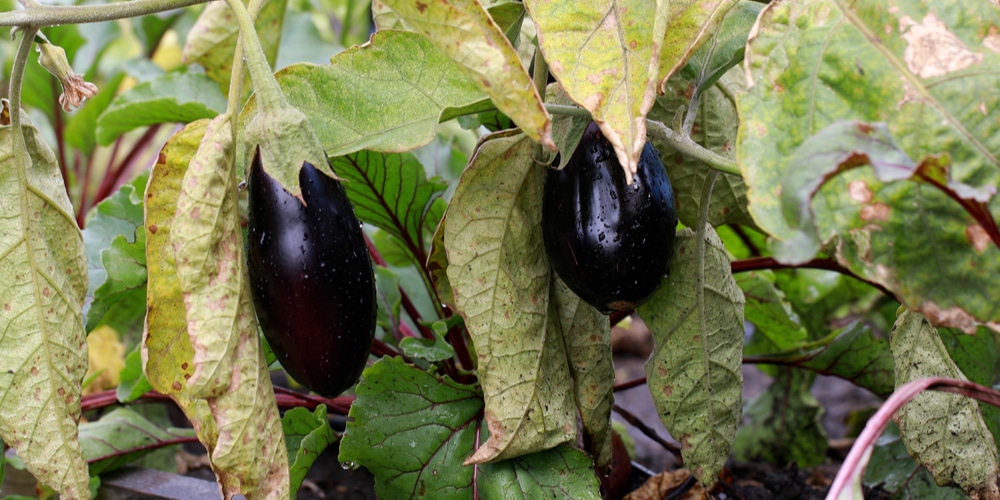You’ve likely been dreaming of the eggplant parmesan and other dishes you’ll be able to make with your bounty of eggplant. So it’s undoubtedly concerning if you notice your eggplant leaves starting to curl. We’ll explore the common causes of eggplant leaves curling and how you can reverse this condition.
Eggplant Leaves Curling
Here are the most common reasons for eggplant leaves curling:
Not Enough Water
Leaf curling in most plants is a classic sign of insufficient water.
Eggplants require about one to two inches of water every week for optimal growth. If you live in a dry or windy area, your eggplants might need even more frequent watering.
Placing mulch around your eggplants—but not directly against their stems—is an excellent way to help retain moisture in the soil.
Ironically, overwatering can also cause eggplant leaves to curl. But instead of them looking shriveled and crumbly, the leaves often have a mushy appearance because they can’t hold their form.
The best way to manage your eggplant’s water needs is to stick your finger in the soil. It should be moist at all times but never soggy.
Spotted Wilt Virus
Spotted wilt virus is a common condition affecting a tomato plant’s leaves, but it can also do the same to eggplant.
Signs of spotted wilt virus in eggplants include:
- Upward or downward cupped leaves
- Bronzing on the top of leaves
- Bronze areas that turn into spots
If your plant is already producing vegetables, it’s also common for spotted wilt virus to impact the purple skin of eggplants. As a result, you’ll notice spots and blotches on your eggplants, usually with a distinct ring around them.
Sadly, it’s impossible to stop spotted wilt virus once it sets into your eggplant leaves. Instead, you’re better off using insecticide for thrips, which are the insects that carry the virus.
Pest Infestation
Many small insects view your eggplant as food, creating damage that can cause its leaves to curl. Some common pests that cause leaf curling through eating eggplant include:
- Aphids
- Spider mites
- Leafhoppers
- Whiteflies
Luckily, if you catch and treat a pest infestation early on, you’ll likely be able to enjoy healthy eggplant vegetables despite the plant’s leaves curling.
So, we recommend using organic insecticide. Proactively applying insecticide the next growing season is also ideal for preventing future eggplant leaf curling and turning yellow.
Too Much Shade
Don’t let the fact that eggplants are in the nightshade family fool you; these plants require six hours of direct, full sunlight per day. Without enough sun, your eggplant leaves will curl.
So, if you placed your eggplants in an area receiving less sun, it’s time to pull out your shovel and transplant them.
When replanting your eggplant in a sunnier spot, use this as an opportunity to check the soil quality. Eggplants require a pH between 5.5 and 7.2 for their leaves to stay green and in good, uncurled health.
Mosaic Virus
Mosaic virus is an umbrella term for diseases that cause eggplants to develop mottled leaves. Curled leaves are also a common side effect of this virus.
Sadly, there isn’t a way to cure mosaic virus, and it’s highly contagious. Therefore, if you determine that this virus is causing your eggplant’s leaves to curl, we encourage you to uproot the plant.
You can then control this virus in future eggplants by using organic insecticides, as insects are the most common transmitters of it.
The Bottom Line
Savvy gardeners know that to see eggplant leaves curling is a blessing; it’s a sign they need to change something before the pest, virus, or poor growing conditions impact their vegetables.
Luckily, reversing an eggplant is possible in many cases, and you can still enjoy a large eggplant harvest.

